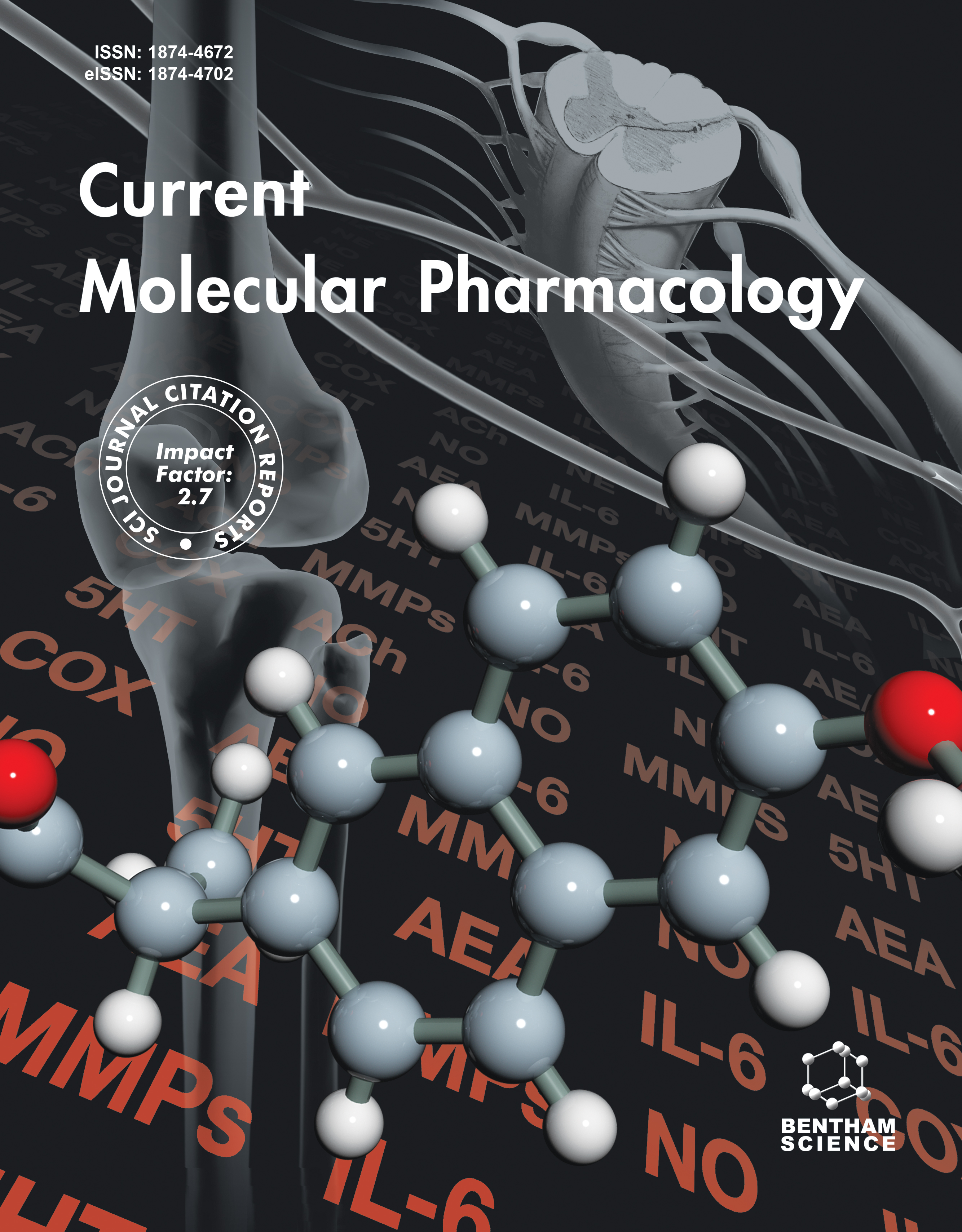- Home
- A-Z Publications
- Current Molecular Pharmacology
- Previous Issues
- Volume 8, Issue 2, 2015
Current Molecular Pharmacology - Volume 8, Issue 2, 2015
Volume 8, Issue 2, 2015
-
-
Pharmacology of L-type Calcium Channels: Novel Drugs for Old Targets?
More LessAuthors: Jorg Striessnig, Nadine J. Ortner and Alexandra PinggeraInhibition of voltage-gated L-type calcium channels by organic calcium channel blockers is a well-established pharmacodynamic concept for the treatment of hypertension and cardiac ischemia. Since decades these antihypertensives (such as the dihydropyridines amlodipine, felodipine or nifedipine) belong to the most widely prescribed drugs world-wide. Their tolerability is excellent because at therapeutic doses their phar Read More
-
-
-
Voltage-gated Calcium Channels and Autism Spectrum Disorders
More LessAuthors: Alexandra F. Breitenkamp, Jan Matthes and Stefan HerzigAutism spectrum disorder is a complex-genetic disease and its etiology is unknown for the majority of cases. So far, more than one hundred different susceptibility genes were detected. Voltagegated calcium channels are among the candidates linked to autism spectrum disorder by results of genetic studies. Mutations of nearly all pore-forming and some auxiliary subunits of voltage gated calcium channels have been Read More
-
-
-
Calcium Channel Mutations in Cardiac Arrhythmia Syndromes
More LessAuthors: Matthew J. Betzenhauser, Geoffrey S. Pitt and Charles AntzelevitchVoltage gated calcium channels are essential for cardiac physiology by serving as sarcolemma- restricted gatekeepers for calcium in cardiac myocytes. Activation of the L-type voltagegated calcium channel provides the calcium entry required for excitation-contraction coupling and contributes to the plateau phase of the cardiac action potential. Given these critical physiological roles, subtle disturbances in L-type cha Read More
-
-
-
Voltage-Gated Cav1 Channels in Disorders of Vision and Hearing
More LessAuthors: Mei-ling A. Joiner and Amy LeeCav1 channels mediate L-type Ca2+ currents that trigger the exocytotic release of glutamate from the specialized “ribbon” synapse of retinal photoreceptors (PRs) and cochlear inner hair cells (IHCs). Genetic evidence from animal models and humans support a role for Cav1.3 and Cav1.4 as the primary Cav channels in IHCs and PRs, respectively. Because of the unique features of transmission at ribbon synapses, Cav1.3 a Read More
-
-
-
Cav1.3 Channels as Key Regulators of Neuron-Like Firings and Catecholamine Release in Chromaffin Cells
More LessAuthors: David H.F. Vandael, Andrea Marcantoni and Emilio CarboneNeuronal and neuroendocrine L-type calcium channels (Cav1.2, Cav1.3) open readily at relatively low membrane potentials and allow Ca2+ to enter the cells near resting potentials. In this way, Cav1.2 and Cav1.3 shape the action potential waveform, contribute to gene expression, synaptic plasticity, neuronal differentiation, hormone secretion and pacemaker activity. In the chromaffin cells (CCs) of the adrenal medulla, Cav1 Read More
-
-
-
Emerging Alternative Functions for the Auxiliary Subunits of the Voltage- Gated Calcium Channels
More LessAuthors: Franz Hofmann, Anouar Belkacemi and Veit FlockerziVoltage gated calcium channels (Cav) are composed of up to five proteins: The ion conducting pore subunit α1 and the auxiliary subunits α2, δ, β, and γ. Recent reports show that Cavα1 and Cavβ comprise the calcium channel core complex and that β, α2 δ and γ may serve additional roles that are independent of the Cavα1 subunit. This short review will summarize these emerging functions.
-
-
-
The R-Domain: Identification of an N-terminal Region of the α2δ-1 Subunit Which is Necessary and Sufficient for its Effects on Cav2.2 Calcium Currents
More LessVoltage-gated calcium channels (Cav) and their associated proteins are pivotal signalling complexes in excitable cell physiology. In nerves and muscle, Cav tailor calcium influx to processes including neurotransmission, muscle contraction and gene expression. Cav comprise a pore-forming α1 and modulatory β and α2δ subunits – the latter targeted by anti-epileptic and anti-nociceptive gabapentinoid drugs. However, the me Read More
-
-
-
Inhibition of Voltage-Gated Calcium Channels by RGK Proteins
More LessAuthors: Zafir Buraei and Jian YangDue to their essential biological roles, voltage-gated calcium channels (VGCCs) are regulated by a myriad of molecules and mechanisms. Fifteen years ago, RGK proteins were discovered to bind the VGCC β subunit (Cavβ) and potently inhibit high-voltage activated Ca2+ channels. RGKs (Rad, Rem, Rem2 and Gem/Kir) are a family of monomeric small GTPases belonging to the superfamily of Ras GTPases. They exert dual inhibit Read More
-
-
-
Towards a Unified Theory of Calmodulin Regulation (Calmodulation) of Voltage-Gated Calcium and Sodium Channels
More LessAuthors: Manu Ben-Johny, Ivy E. Dick, Lingjie Sang, Worawan B. Limpitikul, Po Wei Kang, Jacqueline Niu, Rahul Banerjee, Wanjun Yang, Jennifer S. Babich, John B. Issa, Shin Rong Lee, Ho Namkung, Jiangyu Li, Manning Zhang, Philemon S. Yang, Hojjat Bazzazi, Paul J. Adams, Rosy Joshi-Mukherjee, Daniel N. Yue and David T. YueVoltage-gated Na and Ca2+ channels represent two major ion channel families that enable myriad biological functions including the generation of action potentials and the coupling of electrical and chemical signaling in cells. Calmodulin regulation (calmodulation) of these ion channels comprises a vital feedback mechanism with distinct physiological implications. Though long-sought, a shared understanding of the chan Read More
-
-
-
Essential Roles of Intracellular Calcium Release Channels in Muscle, Brain, Metabolism, and Aging
More LessAuthors: Gaetano Santulli and Andrew R. MarksCalcium (Ca2+) release from intracellular stores controls numerous cellular processes, including cardiac and skeletal muscle contraction, synaptic transmission and metabolism. The ryanodine receptors (RyRs: RyR1, RyR2, RyR3) and inositol 1,4,5-trisphosphate receptors (IP3Rs: IP3R1, IP3R2, IP3R3) are the major Ca2+ release channels (CRCs) on the endo/sarcoplasmic reticulum (ER/SR). RyRs and IP3Rs comprise macromolec Read More
-
Volumes & issues
Most Read This Month
Article
content/journals/cmp
Journal
10
5
false
en


